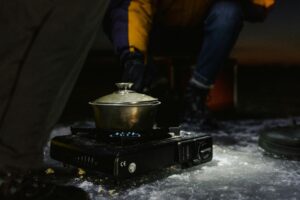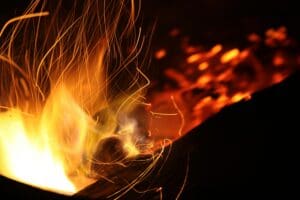1. Choose Your Site Like a Trapper, Not a Tourist
Too many campers pick a spot based on the view. But seasoned backcountry travelers know that where you place your camp matters more than how it looks in photos. Think drainage, wind shelter, fire safety, and proximity to resources.
Check the slope. Avoid low areas where cold air and water pool overnight. Scan for widowmakers—those dead branches above your shelter just waiting to fall. Look for natural windbreaks, level ground, and access to water and fuelwood. Good camp placement is about reading the land like it’s trying to talk to you—because it is.
2. Build a Basecamp, Not a Crash Pad
A real backcountry camp should feel intentional. Even if you’re only there for one night, build it like you’re staying for a week. Lay out a gear zone, prep a fire pit safely, rig up a rain tarp or wind screen, and give yourself a designated area for food prep, rest, and firewood.
This level of campcraft not only boosts efficiency but boosts morale. Everything has a place, and everything gets put to use. When it’s time to move, teardown is faster, cleaner, and more respectful to the land.
3. Rethink Shelter: It’s Not Just About the Tent
Your tent is only one piece of the puzzle. In wet, windy, or cold conditions, adding a tarp shelter changes everything. It becomes a kitchen, a drying station, a social space, or a prep zone when the weather turns.
Know at least two tarp setups by heart—one for rain, one for wind. Bring cordage and field stakes. And remember: trees are tools. Use the landscape to anchor and enhance your shelter strategy.
4. Build a Smarter Fire Zone
If you’re allowed to have a fire, make it count. Don’t just throw down some stones and call it a fire pit. Clear a proper ring, dig a heat-reflecting trench, and stack your firewood by type: tinder, kindling, fuel. Think like you’re cooking, warming, and living by this thing all night—not just watching it.
Add a reflector wall from green logs or stone. Set up a fire-side prep area so your tools and ingredients aren’t scattered in the dirt. The fire isn’t just heat—it’s your backcountry hearth.
5. Sit Like a Human, Not a Hiker
You spend all day hiking. Your legs earn better than a wet log or a lopsided stump. A real backcountry camp deserves a decent place to sit. Bring a lightweight stool or fieldcraft your own from stumps, rocks, or log rounds.
Bonus: learn to lash together a tripod or a simple bush chair. Sitting comfortably changes your mood, helps you cook and prep more easily, and tells your body: this is camp, not just a pause.
6. Cook with Structure, Not Chaos
Too many backcountry meals are made in the dirt with lost utensils and charred food. Build a proper cooking area. Lay out your tools, elevate your cook pot if needed, and organize your ingredients like you’re running a tiny outdoor kitchen.
Use a flat rock, carved notch log, or cook over coals—not open flame. With the right tools and a little prep, your meals can be simple, satisfying, and way better than freeze-dried regret.
7. Go Beyond the Bag: Dial in Your Sleep System
Sleep is survival. Don’t treat it like an afterthought. Whether you’re in a tent, under a tarp, or cowboy camping under stars, your sleep system should match the season and terrain.
Know how to insulate from the ground. Layer with intention. Use a dry bag as a pillow, hot water bottles to pre-warm your bag, and always have a wool layer in reserve. Rest isn’t a luxury out here—it’s fuel for tomorrow.
8. Keep a Dry Zone—Always
Nothing kills morale like soaked gear. Designate a dry zone at camp where wet boots, rain gear, and packs get stripped down and aired out. Use a tarp or tree cover, hang lines early, and build habits around keeping your core kit dry.
Make this part of your camp rhythm—especially when the forecast turns or your clothes are damp from crossing creeks. A dry core is a warm core.
9. Light Up the Right Way
Flashlights are fine. But the backcountry deserves better light discipline. Use red light at night to preserve vision, hang a headlamp from your shelter ceiling with a diffuser for ambient glow, and keep your primary light source close to your sleep system.
Add glow tape to essential gear, and keep a backup battery or fire source handy. Light is safety—but only when it’s where and how you need it.
10. Pack Down Like You Were Never There
The best camps leave no mark. Before you head out, scatter your fire pit, disperse ash, smooth over impressions, and pack out every scrap—no exceptions. Bushcraft isn’t just about using the land—it’s about respecting it.
Your teardown should be methodical and proud. Because when you camp like you mean it, the land trusts you to return.








